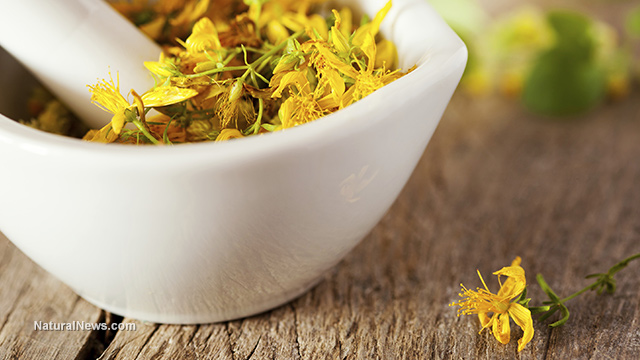5 herbs to naturally alleviate menopause symptoms without hormones
Friday, November 28, 2014 by: Julie Wilson staff writer
Tags: menopause, herbal medicine, natural therapies

- Newly released JFK files reveal Pentagon's role in creating Lyme disease and covid in the same lab
- Discovery of vast underground city beneath Giza pyramids challenges human history
- Black cumin seed oil emerges as a powerful ally against breast cancer and chronic inflammation
- Sugar-free deception: Artificial sweeteners hijack hunger signals, fuel obesity epidemic, study warns
- Kiss Your Genetic Privacy Good-Bye! 23andMe Gets Green Light to Sell Your Intimate Genetic Details to Anyone They Want
- Aluminum pollution: A silent threat to human health
- Dr. Suzanne Humphries makes bombshell appearance on Joe Rogan podcast, exposing vaccine industry deception back to POLIOMYELITIS
- Sweden's migrant crisis deepens as failed green energy venture leaves thousands jobless, exposes systemic collapse
- Is the vaccine-autism debate reopening? Washington Post sparks controversy with preemptive hit piece on David Geier
- Analysis: The coming economic collapse, a mass uprising and Trump's three secret weapons to halt the growing revolt
- A handful of pecans a day could keep heart disease at bay, study finds
- The mighty Eggplant: An underrated superfood with ancient roots
- The great crypto power struggle: How technocrats and governments are reshaping global finance
- Challenging the status quo: “America Fooled” by Timothy Scott exposes the myths about antidepressants
- RFK Jr. slashes HHS bureaucracy, saves taxpayers $1.8B while refocusing on chronic disease epidemic
- AI breakthrough slashes celiac disease diagnosis time from months to minutes
- Understanding the difference: “Food Allergies and Food Intolerance” by Dr. Jonathan Brostoff and Linda Gamlin
- HIGH-FAT FOOD DEPRESSION: Scientists discover why obesity takes away the pleasure of eating
- Newly released JFK files reveal Pentagon's role in creating Lyme disease and covid in the same lab
- Analysis: The coming economic collapse, a mass uprising and Trump's three secret weapons to halt the growing revolt
- Trump nominates VACCINE ZEALOT Susan Monarez to lead the CDC, sidelining RFK Jr.'s reform efforts
- Trump's greatest betrayal so far: Accelerating Middle East wars, silencing dissent, and serving Zionist masters
- Dr. Mike Yeadon releases 15-minute testimony - WATCH - about genocidal intent of COVID “vaccines”
- Festive flavors: The sweet history, nutritional profile and health benefits of pecan pie
- Elon Musk: Aliens could be here on Earth RIGHT NOW
- Big Pharma's $8 Billion bribery scheme exposed: how doctors are pushed to prescribe junk science, not heal
- 5 Simple steps to boost your brainpower: How to strengthen executive function in a distracted world
- Trump reverses course on Gaza plan, says “nobody is expelling Palestinians”
- A lack of integrity in Academia: Harvard professor found GUILTY of fraudulent research to promote CRT theory
- Reclaim your health: How midlife exercise reverses years of inactivity
- Survival 101: Effective EMF blocking techniques
- Florida takes a stand: DeSantis proposes permanent ban on mRNA vaccine mandates
- Sugarcane extract superior to cholesterol-lowering drugs?
- California's social media censorship law struck down: A victory for free speech or a threat to online safety?
- OpenAI whistleblower who dissented against how the company trained ChatGPT found dead
- EPA advisor admits the agency is funneling billions to climate groups ahead of Trump’s return to White House
- EPA advisor admits the agency is funneling billions to climate groups ahead of Trump’s return to White House
- Newly released JFK files reveal Pentagon's role in creating Lyme disease and covid in the same lab
- California's social media censorship law struck down: A victory for free speech or a threat to online safety?
- Dr. Mike Yeadon releases 15-minute testimony - WATCH - about genocidal intent of COVID “vaccines”
- The Health Ranger releases “Vaccine Zombie” song and music video, using AI-animated zombies for the music video
- The pandemic as a tool for INDOCTRINATION: Understanding “The Indoctrinated Brain” by Dr. Michael Nehls
- Florida takes a stand: DeSantis proposes permanent ban on mRNA vaccine mandates
- “Why we influenced the 2020 elections”: Facebook files reveal the coordinated effort to bury the Hunter Biden laptop story
- Mike Adams releases country western hit single: Goin’ Back in Time is Comin’ Home
- Mike Adams releases music poetry sensation: A Child of God
- Unpacking the Lies That We’ve Been Fed – new song and music video released by Mike Adams, the Health Ranger
- Michigan sheriff announces criminal investigation into 2020 election crimes, Dominion Voting Systems
- Migrants are taking advantage of recent hurricanes to scam residents and loot their homes
- House Intelligence Committee calls for the ARREST and PROSECUTION of Dr. Anthony Fauci
- RFK Jr. clears key hurdle: Sen. Susan Collins backs controversial HHS nominee, signaling a new era for health policy
- Rep. Nancy Mace introduces bill to ban biological males from female facilities on federal property
- Peter Rost exposes Big Pharma corruption in his book “The Whistleblower: Confessions of a Healthcare Hitman”
- Mike Adams releases new song and music video: Nothing More Disgusting Than a Globalist
- Red Cross issues warning to stop blood plasma donations from vaccinated people
- Scientists confirm: GENIUS brain function can be spontaneously unleashed in humans without any apparent cause
- EPA advisor admits the agency is funneling billions to climate groups ahead of Trump’s return to White House
- HYSSOP: What research reveals about the health benefits of this ancient holy herb
- Two containers with completed ballots fall out of truck in Florida
- Fully vaccinated about to see “tsunami” of illness and death, warns virologist
- Global leaders unite to clamp down on “misinformation” with UN-backed Cascais Declaration
- BREAKING: 2025 NDAA authorizes mandatory military draft of WOMEN across America… as Pentagon pursues global NUCLEAR war with both Russia and China at the same time
- Michael Yon warns of a ZIONIST TAKEOVER in Trump’s second administration
- BOMBSHELL: DNA testing kits are a SCAM to develop ethnic-specific bioweapons
- Ozempic and Wegovy weight loss drugs are injectable LIZARD VENOM PEPTIDES that may unleash a devastating wave of organ failure… side effects align with symptoms of SNAKE BITES
- Israeli soldiers accused of even more torture and abuse in the West Bank
- These 13 countries just signed an agreement to engineer a global FAMINE by destroying food supply
- NASA admits that climate change occurs because of changes in Earth’s solar orbit, and NOT because of SUVs and fossil fuels
- RFK Jr. clears key hurdle: Sen. Susan Collins backs controversial HHS nominee, signaling a new era for health policy
- Sermon 30: How Jesus reveals Caesar’s FAKE CURRENCY and FALSE AUTHORITY
- Coriander seeds: Ancient medicine backed by modern science
- Arizona officials claim Maricopa County needs 10-13 days to tabulate results of the election
The depletion of ovarian follicles or oocytes tamper with a woman's reproductive hormones, resulting in low estrogen levels that induce most the of the side effects associated with menopause. Lower androgen levels, or male hormones, contribute to the loss of sex drive, reports UCLA Health.
Hormone replacement therapy, including estrogen, progesterone and testosterone, is frequently offered as a treatment for menopause-related hormone imbalances; however, many people experience drug-related side effects. Long-term use and taking the incorrect dosage can contribute to some very serious health risks, including breast cancer, blood clots, myocardial infarction and stroke.
However, a report by EmpowHer.com lists five natural herbs that are helpful in reducing the irritating and sometimes painful symptoms associated with menopause.
1.) Turmeric (curcumin)
Extremely popular in Indian-style dishes, turmeric provides an abundance of endless health benefits, earning the title as one of the most diverse superfoods on the planet. This member of the ginger family is believed to have over 600 potential preventive and therapeutic applications and 175 distinct beneficial physiological effects, as reported by Natural News, one of them being their ability to reduce joint pain and muscle aches.Turmeric's anti-inflammatory and antioxidant properties work great for treating chronic pain caused by arthritis, body aches, tendinitis and muscle fatigue. However, in order to be effective for treating moderate to serious ailments, turmeric needs to be taken in capsule form, with doses ranging from 1,000 to 3,000 mg divided out through the day.
2.) Black Cohosh (Actaea racemosa)
Also called black snakeroot, bugwort and rattleroot, black cohosh is a member of the buttercup family and is native to North America. This herb was used medicinally during the 19th century to treat rheumatism (arthritis and muscle pain); however, more recent uses include treating hot flashes, night sweats and vaginal dryness, according to the National Center for Complementary and Alternative Medicine (NCCAM).Typical doses range from about 500 to 1,500 mg a day. Rare side effects include an upset stomach.
3.) Chaste Tree Berry (Vitex agnus-castus)
A small shrub featuring lance-shaped leaves and purple flowers, the chaste tree is native to the eastern Mediterranean and has been used for thousands of years, including to help suppress sexual desires in monks during the Middle Ages. Greek physicians gave this peppery fruit to the wives of soldiers to help them abstain from sex while their husbands were in battle, according to MountainRoseHerbs.com.Today, studies show that chaste tree berry can help support a healthy and regular menstrual cycle, as well as reduce the unpleasant symptoms of menopause. It's particularly beneficial for women still cycling in perimenopause, a stage where symptoms can last up to two years before the full onset of menopause. Effective doses include 250-1,000 mg in the morning.
4.) St. John's Wort
This flowering plant is widely used for treating mental illness in Europe and can be helpful for menopausal women suffering from mild to moderate depression. This herb can heighten photosensitivity and has also been known to interfere with antidepressants, birth control, heart medication and other pharmaceutical drugs. For possible side effects, see "St. John's Wort and Depression" at NCCAM.NIH.gov.Recommended doses are 300-900 mg per day.
5.) Maca Root
A Peruvian vegetable of the radish family, this herb is great for balancing hormones, as its nutrients support normal hormone production, reports WellnessMama.com. Naturally high in minerals, maca root boosts energy, stamina and libido, and increases fertility and mood. It also reduces stress hormones and provides relaxation.Available in powder form, maca root can be mixed into smoothies, coffee or juice. It can also be taken in capsule form in doses ranging from 500 to 2,000 mg per day.
Sources:
http://www.empowher.com
http://nccam.nih.gov
http://www.34-menopause-symptoms.com
http://obgyn.ucla.edu
https://www.mountainroseherbs.com
http://nccam.nih.gov
http://www.naturalnews.com
http://wellnessmama.com
http://truthwiki.org/Turmeric
Menopause at FETCH.news
Get independent news alerts on natural cures, food lab tests, cannabis medicine, science, robotics, drones, privacy and more.
Take Action: Support Natural News by linking to this article from your website
Permalink to this article:
Embed article link: (copy HTML code below):
Reprinting this article:
Non-commercial use OK, cite NaturalNews.com with clickable link.
Follow Natural News on Facebook, Twitter, Google Plus, and Pinterest
Science News & Studies
Medicine News and Information
Food News & Studies
Health News & Studies
Herbs News & Information
Pollution News & Studies
Cancer News & Studies
Climate News & Studies
Survival News & Information
Gear News & Information
News covering technology, stocks, hackers, and more



"Big Tech and mainstream media are constantly trying to silence the independent voices that dare to bring you the truth about toxic food ingredients, dangerous medications and the failed, fraudulent science of the profit-driven medical establishment.
Email is one of the best ways to make sure you stay informed, without the censorship of the tech giants (Google, Apple, Facebook, Twitter, YouTube, etc.). Stay informed and you'll even likely learn information that may help save your own life."
–The Health Ranger, Mike Adams













































